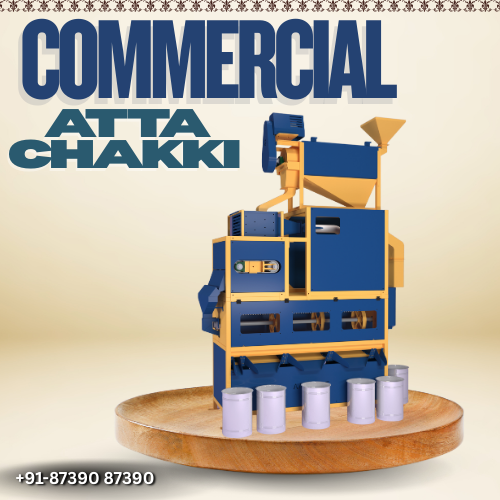
2025’s One-Stop Food Processing Equipment Guide: Why Commercial Atta Chakki Has It All
The food industry in India is growing faster than ever, and with it comes the demand for reliable, efficient, and cost-effective equipment. Whether you run a small restaurant, a large catering service, or a full-scale food production unit, the right machinery can make or break your business.
Among all the innovations in food processing, one piece of equipment stands out in 2025 as a true game-changer—the Commercial Atta Chakki. What was once seen as just a flour-milling machine is now being recognized as a versatile solution that simplifies operations, reduces costs, and ensures quality at every step. Let’s explore why the commercial atta chakki has become a one-stop solution for food businesses this year.
Why the Commercial Atta Chakki is More Than Just a Flour Mill
Traditionally, atta chakkis were seen only as machines to grind wheat into flour. But in 2025, their scope has expanded significantly. Modern commercial atta chakkis are designed with multi-purpose capabilities, offering more than just flour grinding.
- Multi-Grain Milling: From wheat and maize to millets and rice, today’s machines handle multiple grains with ease.
- Consistency & Quality: They ensure uniform texture, which is critical for products like breads, rotis, biscuits, and packaged foods.
- High Output: Unlike domestic units, commercial machines can process large quantities quickly—perfect for bakeries, hotels, and bulk suppliers.
- Energy Efficiency: Newer models are optimized to consume less electricity, helping businesses save on operational costs.
The Role of Atta Chakki in Food Processing in 2025
Meeting Rising Demand for Healthy Foods: Consumers are increasingly choosing fresh, chemical-free, and whole-grain flours. Commercial atta chakkis allow food businesses to offer freshly milled flour, which retains nutrients better than packaged alternatives. This adds a layer of trust and health appeal to your brand.
Boosting Efficiency in Kitchens & Factories: For restaurants and food factories, time is money. With the ability to process grains in bulk, atta chakkis reduce dependence on external suppliers and give kitchens better control over their raw materials.
Reducing Costs and Increasing Profits: Buying flour from suppliers often comes with additional costs. Milling in-house helps businesses cut expenses and maintain steady profit margins—something every food entrepreneur appreciates.
Why Commercial Atta Chakki Is Becoming the One-Stop Equipment in 2025
The real game-changer lies in its versatility and adaptability:
- Customizable Output: Businesses can adjust the fineness of flour depending on whether it’s needed for soft chapatis, crunchy biscuits, or multi-grain breads.
- Compact Yet Powerful: Unlike bulky traditional machinery, modern atta chakkis are space-efficient yet deliver high performance.
- Ease of Maintenance: With stainless steel designs and advanced technology, cleaning and upkeep are hassle-free.
- Durability: Built to last, these machines withstand heavy use—an essential for commercial setups.
By addressing multiple needs with a single machine, the atta chakki is saving businesses from investing in several pieces of equipment.
Key Trends in Food Processing Equipment for 2025
To understand why the commercial atta chakki stands out, it helps to look at the larger food equipment trends this year:
- Automation Everywhere: From packaging to grinding, automation is reducing human error and boosting efficiency.
- Compact Solutions: Kitchens and food factories are looking for smaller, smarter machines that can multitask.
- Sustainability Matters: Energy-efficient equipment is becoming non-negotiable.
- Customizable Machines: Equipment that adapts to different products is in high demand.
The commercial atta chakki ticks all these boxes, making it one of the most sought-after machines in 2025.
Who Should Invest in a Commercial Atta Chakki?
- Restaurants & Hotels: Fresh, in-house flour means consistent quality for breads, rotis, parathas, and baked goods.
- Catering Services: Large events require bulk flour in varying consistencies—something the chakki delivers effortlessly.
- Food Manufacturers: For packaged flour, snacks, and bakery products, controlling the milling process ensures better quality control.
- Retailers & Startups: Entrepreneurs can set up mini flour-milling businesses with relatively low investment.
In short, whether you’re a small café or a big production unit, the atta chakki adapts to your scale.
Practical Tips Before Buying a Commercial Atta Chakki
- Understand Your Capacity Needs: Small restaurants may not need the same output as large factories.
- Check for Energy Efficiency: Machines with lower electricity consumption cut costs in the long run.
- Focus on Durability: Stainless steel bodies and heavy-duty motors ensure the machine lasts.
- Ask About After-Sales Service: A reliable service network is essential to keep your machine running smoothly.
- Think Ahead: Choose a model that can handle different grains and textures to future-proof your business.
Final Thoughts: The Smart Choice for 2025
As the food industry evolves, equipment that offers versatility, reliability, and cost-effectiveness becomes invaluable. In 2025, the Commercial Atta Chakki isn’t just a flour mill—it’s a complete solution for food businesses, making it a must-have for anyone serious about scaling operations.
At Aatomize, we believe that the right equipment doesn’t just support your business—it transforms it. If you’re ready to take your food processing setup to the next level, investing in a commercial atta chakki might just be the smartest move you make this year.